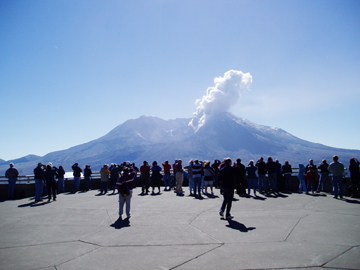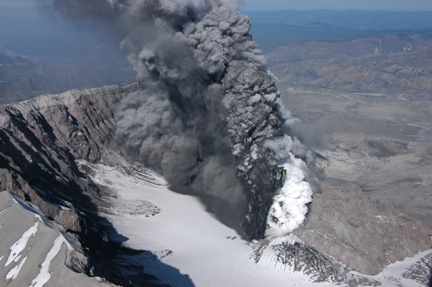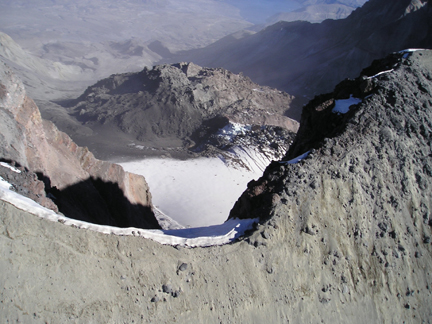Geotimes

Untitled Document

Web Extra
Friday, October 1, 2004 Updated
at 4:00 p.m. EDT, Monday, Oct. 4, 2004.
 Mount
St. Helens erupts steam and ash
Mount
St. Helens erupts steam and ash
More than a week after seismic activity began, Mount St. Helens in Washington
erupted on Friday afternoon with a thick plume of white steam and light ash.
Since then, additional steam-and-ash emissions have occurred and will likely
continue, prompting officials on Saturday to raise the alert level to Volcano
Alert, which is the highest level and indicates that an eruption could be imminent.
Aviation warnings are at color-code Red, also the highest level. Parts of the
surrounding area, including the Johnston Ridge Observatory, have been evacuated
as a precaution.
Mount St. Helens has erupted several
times since its initial steam-and-ash eruption on Friday, pictured here. Geologists
are constantly monitoring the volcano for signs of further activity. All photos
courtesy of the U.S. Geological Survey.
Although seismicity quieted down at first after Friday's 24-minute eruption,
it picked back up again within a few hours, with small earthquakes (maximum
magnitude-3.0) occurring at rates of one to two per minute. The next day, the
volcano had another small eruption of steam and ash. After yet another small
eruption on Sunday night, the volcano awoke on Monday morning with two eruptive
events.
 Monday's
events, however, are different from the previous few days' steam-and-ash eruptions,
said geologist Willie Scott in a press conference held by the U.S. Geological
Survey's Cascades Volcano Observatory. Two eruptive clouds, which looks to be
predominantly, if not all, steam, rose several thousand feet above the summit
of Mount St. Helens, but were not accompanied by seismic signals or waves that
indicate movement, he said. Instead, the steam events indicate that magma or
gas must have moved close to the surface and to the glacier, and have basically
started "boiling the glacier" to produce steam. Hot gases from the
volcano may have vaporized ice and snow contained in the glacier in the summit
crater to produce the steam eruption. Background earthquakes have continued
at the same rate as occurred with the other eruptions, but there was no onset
of larger earthquakes such as occurred prior to the steam-and-ash eruptions
on Friday, Saturday and Sunday.
Monday's
events, however, are different from the previous few days' steam-and-ash eruptions,
said geologist Willie Scott in a press conference held by the U.S. Geological
Survey's Cascades Volcano Observatory. Two eruptive clouds, which looks to be
predominantly, if not all, steam, rose several thousand feet above the summit
of Mount St. Helens, but were not accompanied by seismic signals or waves that
indicate movement, he said. Instead, the steam events indicate that magma or
gas must have moved close to the surface and to the glacier, and have basically
started "boiling the glacier" to produce steam. Hot gases from the
volcano may have vaporized ice and snow contained in the glacier in the summit
crater to produce the steam eruption. Background earthquakes have continued
at the same rate as occurred with the other eruptions, but there was no onset
of larger earthquakes such as occurred prior to the steam-and-ash eruptions
on Friday, Saturday and Sunday.
Friday's eruption at Mount St. Helens
was both ash and steam, as seen here. Monday's eruptions were predominantly
steam, indicating that magma is rising toward the surface.
"This is pretty good evidence that we have something very hot near the
surface," Scott said, but it does not indicate any greater or less likelihood
that a magma eruption will occur soon. Scientists are monitoring the volcano
by taking thermal images of the dome and the crater, flying over the volcano
to measure the gases being released and monitoring GPS instruments for ground
deformation. But, Scott said, it is likely the volcano will "go without
any warning at all." If that occurred, the eruption would be rich in ash
that could reach 50,000 feet in altitude, and would produce lava and last tens
of minutes to hours. He said the scientists will be looking for all possible
indications that something bigger is about to occur, but "all options are
open right now. It's best just to watch and see what happens."
 One
interesting thing to note, Scott said, is that the lava dome around the glacier
has seen intense deformation over the past few days — around 100 feet.
Furthermore, new cracks have popped up on the dome and in the glacier —
all indications that "somewhere down the line, we [can] expect an explosive
eruption." The cracks might lead to a greater likelihood of a larger, magma
and ash-rich eruption, Scott said, because the magma would have more escape
options. All of the events so far, he said, have been "expectable."
One
interesting thing to note, Scott said, is that the lava dome around the glacier
has seen intense deformation over the past few days — around 100 feet.
Furthermore, new cracks have popped up on the dome and in the glacier —
all indications that "somewhere down the line, we [can] expect an explosive
eruption." The cracks might lead to a greater likelihood of a larger, magma
and ash-rich eruption, Scott said, because the magma would have more escape
options. All of the events so far, he said, have been "expectable."
The lava dome atop Mount St. Helens
has been growing and deforming significantly since activity began there last
week. It has deformed more than 100 feet, according to USGS geologists.
Indeed, "this is pretty much exactly what we expected to happen,"
says Jim Vallance, a geologist at CVO. From 1981 to 1986, "we saw a lot
of events like this," in which steam and ash erupted and quiesced. The
last eruption of Mount St. Helens was in 1986, six years after the major eruption
on May 18, 1980, that blasted away the entire top and northwest face of the
mountain releasing 24 megatons of thermal energy.
Geologists are continuing to monitor the volcano to see what happens next.
Last updated at 4:00 p.m. EDT, Oct. 4, 2004.
Megan Sever
Links:
Article
on MSNBC.com
Seattle
Times coverage
"Mount
St. Helens could erupt in days to months," Geotimes Web Extra, Oct.
1, 2004
Mount
St. Helens VolcanoCam
U.S.
Geological Survey Cascades Volcano Observatory
Past related Geotimes stories:
"Paths
of Destruction: The Hidden Threat at Mount Rainier," April 2004
"Mount
St. Helens 20 Years Later: What We've Learned," May 2000
Back to top
Untitled Document

 Monday's
events, however, are different from the previous few days' steam-and-ash eruptions,
said geologist Willie Scott in a press conference held by the U.S. Geological
Survey's Cascades Volcano Observatory. Two eruptive clouds, which looks to be
predominantly, if not all, steam, rose several thousand feet above the summit
of Mount St. Helens, but were not accompanied by seismic signals or waves that
indicate movement, he said. Instead, the steam events indicate that magma or
gas must have moved close to the surface and to the glacier, and have basically
started "boiling the glacier" to produce steam. Hot gases from the
volcano may have vaporized ice and snow contained in the glacier in the summit
crater to produce the steam eruption. Background earthquakes have continued
at the same rate as occurred with the other eruptions, but there was no onset
of larger earthquakes such as occurred prior to the steam-and-ash eruptions
on Friday, Saturday and Sunday.
Monday's
events, however, are different from the previous few days' steam-and-ash eruptions,
said geologist Willie Scott in a press conference held by the U.S. Geological
Survey's Cascades Volcano Observatory. Two eruptive clouds, which looks to be
predominantly, if not all, steam, rose several thousand feet above the summit
of Mount St. Helens, but were not accompanied by seismic signals or waves that
indicate movement, he said. Instead, the steam events indicate that magma or
gas must have moved close to the surface and to the glacier, and have basically
started "boiling the glacier" to produce steam. Hot gases from the
volcano may have vaporized ice and snow contained in the glacier in the summit
crater to produce the steam eruption. Background earthquakes have continued
at the same rate as occurred with the other eruptions, but there was no onset
of larger earthquakes such as occurred prior to the steam-and-ash eruptions
on Friday, Saturday and Sunday. 
 Mount
St. Helens erupts steam and ash
Mount
St. Helens erupts steam and ash
 One
interesting thing to note, Scott said, is that the lava dome around the glacier
has seen intense deformation over the past few days — around 100 feet.
Furthermore, new cracks have popped up on the dome and in the glacier —
all indications that "somewhere down the line, we [can] expect an explosive
eruption." The cracks might lead to a greater likelihood of a larger, magma
and ash-rich eruption, Scott said, because the magma would have more escape
options. All of the events so far, he said, have been "expectable."
One
interesting thing to note, Scott said, is that the lava dome around the glacier
has seen intense deformation over the past few days — around 100 feet.
Furthermore, new cracks have popped up on the dome and in the glacier —
all indications that "somewhere down the line, we [can] expect an explosive
eruption." The cracks might lead to a greater likelihood of a larger, magma
and ash-rich eruption, Scott said, because the magma would have more escape
options. All of the events so far, he said, have been "expectable."
